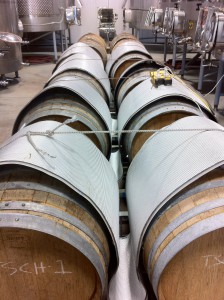There have been a few surreal moments over the past two weeks, not least during the drive to work each day, the backdrop to which is a landscape that seems more properly suited to a fantasy film or, at the very least, an extreme sports holiday. Central Otago is surely one of the most spectacular wine regions I’ve visited, brushing aside the prettiness of intensive viticulture for vast mountain ranges and pristine lakes. As a tourist, I’ve enjoyed three visits here, but this time I’m hard at work, doing vintage at Terra Sancta.
Having grown out of an acquisition of Olssens Garden Vineyard by prominent New Zealand businessman Mark Weldon, Terra Sancta now draws on three estate vineyards in Bannockburn, including the oldest planting on Felton Road. A range of aromatic whites grace the portfolio, but the main game is Pinot Noir, in both rosé and red forms. The winemaking team comprises Jen Parr and Jody Pagey, while viticulture is headed by Len Ibbotson. I’m one of three cellarhands. Working in a small team is wonderful in that I’m able to have regular chats with Jen, Jody and Len, getting great insights into their approaches and experiences.
 A couple of days in, Jen asked me to put blankets on some Chardonnay barrels so they’d start fermenting. The idea so tickled me that I couldn’t resist taking a photo. Going from McLaren Vale, with its high-thirties days to Central Otago, where autumn frosts are a real threat to harvest, is like entering another winemaking world. Warming is a real issue, and we’re often having to warm tanks to prepare them for innoculation. Fruit comes in at fifteen degrees at two in the afternoon. Acids are stratospheric. There’s a tub in the winery marked “sugar.” I regularly wear three layers, two of which are made of merino, and my terry towelling bucket hat is completely without use.
A couple of days in, Jen asked me to put blankets on some Chardonnay barrels so they’d start fermenting. The idea so tickled me that I couldn’t resist taking a photo. Going from McLaren Vale, with its high-thirties days to Central Otago, where autumn frosts are a real threat to harvest, is like entering another winemaking world. Warming is a real issue, and we’re often having to warm tanks to prepare them for innoculation. Fruit comes in at fifteen degrees at two in the afternoon. Acids are stratospheric. There’s a tub in the winery marked “sugar.” I regularly wear three layers, two of which are made of merino, and my terry towelling bucket hat is completely without use.
There’s no question that New Zealanders take their Pinot Noir very seriously. This is my first experience of making Pinot, and the process does seem somewhat more finicky than the rough and tumble of McLaren Vale Shiraz. Terra Sancta’s winery is of a sufficient capacity to allow extended time on skins, so we’re cold-soaking, gently plunging during ferment, leaving wine on skins post-ferment and generally allowing each parcel to go through a fairly disciplined winemaking process. The condition of the fruit coming in has been spectacularly good, due no doubt to sound viticulture but also a dry growing season. Although the winery is state-of-the-art, tonnage isn’t huge and cellar practices are firmly artisanal (no must pumps, for example) so there’s a lot of manual handling along the way.
Even as I become more knowledgeable and confident with cellar operations (though I still come across new things every day), landing in the world of cool climate Pinot Noir has thrown my sense of wine and it’s been an educational challenge to get my head around not only the vastly different berry composition of the fruit here but the sensory aspects and how these influence winemaking decisions. These aren’t shallow considerations; it would take years to get comfortable with a region and its styles, to master the vinification of fruit from specific vineyards. I like the idea of that deep dive, and it’s something that appeals to me when I think of my own plans, even as the urge to see more regions and different fruit remains.
For now, though, I’m excited to taste all the batches we are working on each day, some ultra-fragranced, some dark and more structured, yet others rich and fully fruited. Maximising extract isn’t the game; it’s more about gentle management and getting enough structure from the fruit while preserving the delicacy of the variety. As with my experience in McLaren Vale, some parcels have looked stunning from day one, and I’m especially enjoying their transformation through fermentation, seeing which characters persist through that process and which morph into something else. The aromatic whites are fun to make too, particularly off-dry styles, and I’ll be very interested to see how they compare with those I’ll be working on in the Mosel later this year.
Most of our fruit should be in by the end of the week, and we’ll soon start pressing the first of the reds. As always, a huge amount for me to learn.
Whist you are in NZ call in and see Larry McKenna he’s a top bloke.
Hey Tim! I really need to come back over here at some stage and visit a few great folks – this whole vintage malarkey is eating into my travel time!